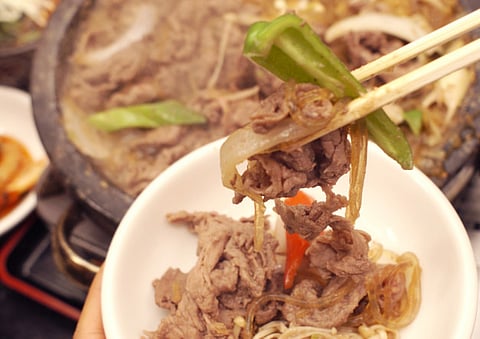19 things you didn’t know about Korean cuisine
A traditional meal includes dishes in five different colours. Royal and temple foods taste similar. And rice was once used to pay taxes. Wonder why? Read on to find out

Wedged between ancient civilisations, China on the land side and Japan on the sea, Korea still manages to retain its own culture, philosophy and cuisine. Korea has made its presence felt in the world of movies, music and electronics, with food never too far behind. GN Focus presents some facts you didn’t know about their food.
1. It’s hot! Korean food is hot and spicy — one of the important ingredients being gochujang (fermented red chilli paste). Onions, garlic, scallions, ginger, sesame oil, doenjang (fermented soybean paste) and powdered red pepper are popular spices.
2. It is also harmonious. The strong Korean belief in eumyangohaeng (yin and yang) is reflected in its food as well, which is nutritionally balanced in terms of colours, textures and flavours. A traditional Korean table includes dishes or garnishes of five different colours to represent the earth’s five elements.
3. Koreans eat with metal chopsticks and a spoon. Wood-poor Korea has been using metal chopsticks for more than a thousand years and a spoon for soups and rice. Korean chopsticks are shorter than their Chinese counterparts and, unlike Japanese chopsticks, are not pointed at their ends.
4. Pots, not woks. Korean recipes don’t call for a wok, so essential to Chinese cooking. Stone and glazed earthenware pots are used instead.
5. Rice was used to pay taxes. Rice is central to Korean cooking. In the Three Kingdoms Period, considered to be the late Iron Age, rice was so important in the kingdom of Silla that it was used to pay tributes and taxes.
7. Cattle had a day off. Cattle had an important cultural role in the Korean home and were considered equal to human servants, or in some cases, even members of the family, and were given an annual holiday on the first Cow day of the lunar New Year.
8. Fermented food is central to the Korean table. Gochujang, doenjang and ganjang, the three important bases of most Korean dishes, are all fermented products. Kimchi, the country’s national dish, is fermented underground for a year before consumption.
9. Koreans love mung beans. Although native to the Indian subcontinent, mung beans are served as a side dish, used to make cellophane noodles and in porridges.
10. Vegetables are big. Koreans believe food is medicine — if you eat well, your mind and body will both benefit. Medicinal herbs, such as ginseng, reishi and wolfberry are often used in their cooking. Korean recipes call for lots of vegetables and several types of wild greens such as bracken shoots and Korean bellflower root.
11. Foods are served all at once. Unlike Western meals that are served in multiple courses, a Korean expects all dishes to be served together. The table decoration changes according to the number of items being served, with the number of banchan or side dishes anywhere between five and 12.
12. Raw meat has its place. Koreans enjoy a kind of raw meat preparation called hoe. Yukhoe is minced beef served raw with soy sauce, sugar, salt, spring onions, minced garlic, sesame oil, sesame seeds, black pepper and julienned Korean pears.
13. Meat is often so fresh, it’s still moving. The controversial dish sannakji is a preparation of octopus, which is cut up and served immediately, spiced with sesame seeds and sesame oil. It can present a choking hazard as the suction cups on the arm pieces are still active.
14. Dogs make a good bite. Dog meat has been savoured in Korea since antiquity. It is consumed during the summer months with the belief that it balances the body and is good for health. In modern times, a section of the Korean population is against eating dog meat.
15. Bulgogi was ranked 23 in the World’s 50 Most Delicious Foods readers’ poll compiled by CNNGo in 2011. Bulgogi refers to a variety of grilled sirloin and prime cuts of beef, marinated in soy sauce, sugar, sesame oil, garlic, pepper, scallions, mushrooms and onions.
16. Waffles are a hit. Modern Koreans love Belgian waffles with ice cream. The traditional variation of waffles, bungeoppang, is a fish-shaped pastry filled with red bean paste.
17. There’s no concept of dessert. Not as the West sees it, anyway. There are varieties of confectionery — tteok (sweet rice cakes) and hangwa (traditional confectionery). A Korean meal generally finishes with green tea or beverages.
18. Korean tea has many flavours. It can be bitter, sweet and astringent to salty and sour. Tea was first introduced in Korea as a thrice-daily offering to god in a small tea ceremony. Early teahouses were founded in and around monasteries and later spread to further, with as many as 15 kinds of tea ceremonies with varying degrees of formality.
19. Royal and temple foods are similar. Commoners and royals ate differently in pre-modern Korea. Interestingly, royal court cuisine is closely related to Korean temple cuisine, as maids assigned to the royal kitchens would grow old and leave the palaces to join Buddhist monasteries as nuns, taking the recipes with them.
Sign up for the Daily Briefing
Get the latest news and updates straight to your inbox



